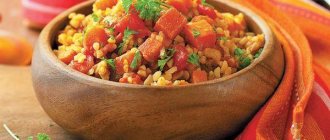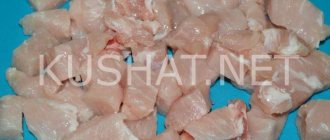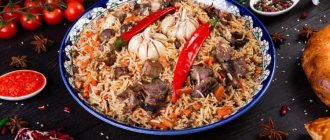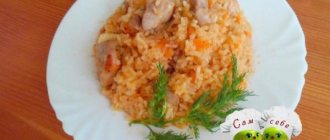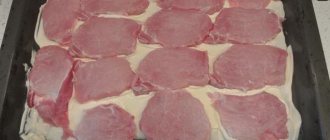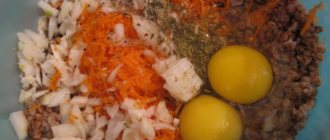A little history
Pilaf is a very ancient dish, the principles of its preparation were formed in India and the Middle East. At the end of the 17th century, envoys of the French royal court, returning from Turkey, spoke with delight about an amazingly tasty dish of rice and meat, seasoned with saffron and turmeric. But French chefs were unable to cook real pilaf. Using traditional techniques of national cuisine, they created a porridge with meat and sauce, which they gave the name “Miroton”. It was only in the 19th century that the original pilaf recipe came to Western Europe. Since then, this dish has become a constant on the everyday and festive table of Europeans.
The classic dish is prepared from rice, beef, vegetables, and seasoned with spices. But the old recipe underwent many changes, ingredients changed, technology improved. As a result, today there are about a thousand options for preparing this dish. For example, you can cook very tasty pilaf with buckwheat. The recipe and photo of the dish are presented below.
Buckwheat-rice porridge with meat - step-by-step photo recipe
Prepare ingredients for buckwheat-rice porridge. Heat a little sunflower oil in a deep saucepan and fry the onion, cut into half rings. As soon as the onion becomes transparent, add the meat chopped into small pieces and seasoned with spices. Fry the meat and onions over medium heat for about 5 minutes, and then add chopped champignons and carrots cut into strips. Pour half a glass of boiling water into the saucepan, cover with a lid and simmer the meat and vegetables for about 30 minutes. During this time, sort out the buckwheat and rice from the garbage. Rinse them, dry them and combine. Pour rice and buckwheat into a saucepan, stir and pour salted water over everything. Simmer the porridge over low heat until all the liquid has boiled away. Let the finished porridge of rice and buckwheat stand for 20 minutes, wrapping the saucepan in a warm towel, and then place it on plates and sprinkle with fresh herbs. Hearty, aromatic and very, very tasty porridge will definitely please your family and friends.
Ingredients
What the hostess will need:
- buckwheat - 1 kilogram;
- pork ribs - 0.5 kg;
- pork pulp - 0.5 kg;
- large onions - 7 pieces;
- large carrots - 3 pieces;
- garlic - 1 head;
- vegetable oil (refined sunflower oil is best) - 0.5 cups;
- water - 1.5 liters;
- salt - to taste;
- ground allspice - 0.5 teaspoon;
- seasoning for pilaf - 1 teaspoon.
As you can see, all products are affordable, they can be bought in any store and inexpensively. From this amount of ingredients you will get a large cauldron of pilaf. There will definitely be enough for the guests.
Pilaf with mushrooms and celery
Ingredients:
- 200 g buckwheat.
- 300 g celery roots.
- 3 onions.
- 3 carrots.
- 300 g champignons (can be replaced with other mushrooms).
- 50 ml plant. oils
- 4 cloves of garlic.
- Half a bunch of parsley and dill.
- Spices.
- Salt.
Preparation:
- Cut the carrots into strips.
- Cut the celery root into the same strips.
- Chop the onion into half rings.
- Simmer the vegetables in vegetable oil for a few minutes until they soften a little.
- Then take care of the mushrooms. Cut them into strips or slices. Fry them in a separate frying pan until the moisture evaporates and the mushrooms themselves darken a little.
- Sell the garlic through a press. Add it to the mushrooms at the end of frying, stir and keep on fire for another 1-2 minutes.
- Place fried vegetables in a cauldron or thick-walled pan.
- Then a layer of mushrooms. Salt, add spices.
- Top with a ball of sorted and washed buckwheat. Flatten the grain. Pour boiling water over it so that the buckwheat is covered by 1-1.5 cm.
- Cover the pan with a lid and bring to a boil over high heat. Then reduce the heat to low and cook until the liquid has completely evaporated. At this point the buckwheat should be ready. If not, add a little more water and continue cooking until done.
- Then turn off the heat, wrap the pan tightly with a towel and leave for 15 minutes.
- Mix the finished pilaf and serve, sprinkled with finely chopped herbs.
Preparation
How to cook real buckwheat pilaf, and not just delicious porridge with meat? To do this, you need to follow a certain technology. So, let’s prepare step-by-step authentic buckwheat pilaf with meat.
First, heat up the cauldron, pour sunflower oil into it, lay out large pieces of onion and fry them completely. That is, we will fry in oil until the onion turns dark brown. After this, use a slotted spoon to remove all the pieces so that the oil remains clean (you can strain it).
Next, place the ribs in a cauldron, fry them over medium heat until they are beautifully golden brown, and place them on a plate. Now it’s the turn of the sirloin, which we also send to the cauldron and fry on all sides, and then put on a plate with the ribs.
Pour the onion into the cauldron, bring it to a golden color, then add the carrots. Cook it until soft: over medium heat for about 10 minutes, stirring occasionally. When the vegetables are ready, you need to return the meat to the cauldron, while laying it in a layer on the onions and carrots.
Now you need to heat the water well in a separate bowl, since you cannot pour it cold into the cauldron, so as not to reduce the temperature of the sunflower oil. Dissolve salt and spices in water, carefully pour over meat and vegetables. Place washed but not peeled garlic in the middle (just rinse the whole head under the tap and do not disassemble it, cut off the roots with a knife) and add dry cereal. At this stage, buckwheat pilaf can no longer be disturbed. Just close the cauldron with a lid, reduce the heat slightly and wait 30-35 minutes. After this time, the cauldron can be removed from the heat. The dish is ready!
Buckwheat pilaf recipe. Calorie, chemical composition and nutritional value.
Nutritional value and chemical composition of “Buckwheat pilaf”.
The table shows the nutritional content (calories, proteins, fats, carbohydrates, vitamins and minerals) per 100 grams of edible portion.
| Nutrient | Quantity | Norm** | % of the norm in 100 g | % of the norm in 100 kcal | 100% normal |
| Calorie content | 93.1 kcal | 1684 kcal | 5.5% | 5.9% | 1809 |
| Squirrels | 7.1 g | 76 g | 9.3% | 10% | 1070 g |
| Fats | 2.7 g | 56 g | 4.8% | 5.2% | 2074 g |
| Carbohydrates | 9.6 g | 219 g | 4.4% | 4.7% | 2281 g |
| Organic acids | 0.1 g | ~ | |||
| Alimentary fiber | 2.3 g | 20 g | 11.5% | 12.4% | 870 g |
| Water | 78.5 g | 2273 g | 3.5% | 3.8% | 2896 g |
| Ash | 0.726 g | ~ | |||
| Vitamins | |||||
| Vitamin A, RE | 264 mcg | 900 mcg | 29.3% | 31.5% | 341 g |
| Retinol | 0.002 mg | ~ | |||
| beta carotene | 1.573 mg | 5 mg | 31.5% | 33.8% | 318 g |
| Lutein + Zeaxanthin | 28.161 mcg | ~ | |||
| Vitamin B1, thiamine | 0.079 mg | 1.5 mg | 5.3% | 5.7% | 1899 |
| Vitamin B2, riboflavin | 0.083 mg | 1.8 mg | 4.6% | 4.9% | 2169 g |
| Vitamin B4, choline | 23.2 mg | 500 mg | 4.6% | 4.9% | 2155 g |
| Vitamin B5, pantothenic | 0.109 mg | 5 mg | 2.2% | 2.4% | 4587 g |
| Vitamin B6, pyridoxine | 0.204 mg | 2 mg | 10.2% | 11% | 980 g |
| Vitamin B9, folates | 7.846 mcg | 400 mcg | 2% | 2.1% | 5098 g |
| Vitamin B12, cobalamin | 0.156 mcg | 3 mcg | 5.2% | 5.6% | 1923 |
| Vitamin C, ascorbic acid | 0.8 mg | 90 mg | 0.9% | 1% | 11250 g |
| Vitamin E, alpha tocopherol, TE | 0.757 mg | 15 mg | 5% | 5.4% | 1982 |
| gamma tocopherol | 0.018 mg | ~ | |||
| Vitamin H, biotin | 1.578 mcg | 50 mcg | 3.2% | 3.4% | 3169 g |
| Vitamin K, phylloquinone | 3.6 mcg | 120 mcg | 3% | 3.2% | 3333 g |
| Vitamin RR, NE | 2.5505 mg | 20 mg | 12.8% | 13.7% | 784 g |
| Niacin | 0.665 mg | ~ | |||
| Betaine | 2.688 mg | ~ | |||
| Macronutrients | |||||
| Potassium, K | 162.35 mg | 2500 mg | 6.5% | 7% | 1540 g |
| Calcium, Ca | 13.89 mg | 1000 mg | 1.4% | 1.5% | 7199 g |
| Silicon, Si | 15.262 mg | 30 mg | 50.9% | 54.7% | 197 g |
| Magnesium, Mg | 40.39 mg | 400 mg | 10.1% | 10.8% | 990 g |
| Sodium, Na | 28.29 mg | 1300 mg | 2.2% | 2.4% | 4595 g |
| Sera, S | 21.8 mg | 1000 mg | 2.2% | 2.4% | 4587 g |
| Phosphorus, Ph | 102.6 mg | 800 mg | 12.8% | 13.7% | 780 g |
| Chlorine, Cl | 17.03 mg | 2300 mg | 0.7% | 0.8% | 13506 g |
| Microelements | |||||
| Aluminium, Al | 101.1 mcg | ~ | |||
| Bor, B | 101.8 mcg | ~ | |||
| Vanadium, V | 37.08 mcg | ~ | |||
| Iron, Fe | 1.318 mg | 18 mg | 7.3% | 7.8% | 1366 g |
| Yod, I | 1.53 mcg | 150 mcg | 1% | 1.1% | 9804 g |
| Cobalt, Co | 1.353 mcg | 10 mcg | 13.5% | 14.5% | 739 g |
| Lithium, Li | 1.406 mcg | ~ | |||
| Manganese, Mn | 0.2765 mg | 2 mg | 13.8% | 14.8% | 723 g |
| Copper, Cu | 126.41 mcg | 1000 mcg | 12.6% | 13.5% | 791 g |
| Molybdenum, Mo | 8.129 mcg | 70 mcg | 11.6% | 12.5% | 861 g |
| Nickel, Ni | 2.609 mcg | ~ | |||
| Rubidium, Rb | 72.3 mcg | ~ | |||
| Selenium, Se | 6.727 mcg | 55 mcg | 12.2% | 13.1% | 818 g |
| Strontium, Sr | 43.11 mcg | ~ | |||
| Titanium, Ti | 4.55 mcg | ~ | |||
| Fluorine, F | 54.17 mcg | 4000 mcg | 1.4% | 1.5% | 7384 g |
| Chromium, Cr | 1.22 mcg | 50 mcg | 2.4% | 2.6% | 4098 g |
| Zinc, Zn | 0.8527 mg | 12 mg | 7.1% | 7.6% | 1407 g |
| Zirconium, Zr | 4.82 mcg | ~ | |||
| Digestible carbohydrates | |||||
| Starch and dextrins | 7.601 g | ~ | |||
| Mono- and disaccharides (sugars) | 2.1 g | max 100 g | |||
| Glucose (dextrose) | 0.573 g | ~ | |||
| Lactose | 0.004 g | ~ | |||
| Maltose | 0.023 g | ~ | |||
| Sucrose | 1.422 g | ~ | |||
| Fructose | 0.299 g | ~ | |||
| Essential amino acids | 0.08 g | ~ | |||
| Arginine* | 0.532 g | ~ | |||
| Valin | 0.335 g | ~ | |||
| Histidine* | 0.195 g | ~ | |||
| Isoleucine | 0.314 g | ~ | |||
| Leucine | 0.545 g | ~ | |||
| Lysine | 0.561 g | ~ | |||
| Methionine | 0.191 g | ~ | |||
| Methionine + Cysteine | 0.095 g | ~ | |||
| Threonine | 0.303 g | ~ | |||
| Tryptophan | 0.085 g | ~ | |||
| Phenylalanine | 0.292 g | ~ | |||
| Phenylalanine+Tyrosine | 0.157 g | ~ | |||
| Nonessential amino acids | 0.168 g | ~ | |||
| Alanin | 0.395 g | ~ | |||
| Aspartic acid | 0.674 g | ~ | |||
| Glycine | 0.339 g | ~ | |||
| Glutamic acid | 1.197 g | ~ | |||
| Proline | 0.28 g | ~ | |||
| Serin | 0.303 g | ~ | |||
| Tyrosine | 0.255 g | ~ | |||
| Cysteine | 0.108 g | ~ | |||
| Sterols (sterols) | |||||
| Cholesterol | 24.06 mg | max 300 mg | |||
| beta sitosterol | 9.256 mg | ~ | |||
| Fatty acid | |||||
| Trans fats | 0.005 g | max 1.9 g | |||
| monounsaturated trans fats | 0.004 g | ~ | |||
| Saturated fatty acids | |||||
| Saturated fatty acids | 0.5 g | max 18.7 g | |||
| 10:0 Kaprinovaya | 0.001 g | ~ | |||
| 12:0 Lauric | 0.001 g | ~ | |||
| 14:0 Miristinovaya | 0.006 g | ~ | |||
| 15:0 Pentadecane | 0.001 g | ~ | |||
| 16:0 Palmitinaya | 0.351 g | ~ | |||
| 17:0 Margarine | 0.001 g | ~ | |||
| 18:0 Stearic | 0.118 g | ~ | |||
| 20:0 Arakhinovaya | 0.006 g | ~ | |||
| 22:0 Begenovaya | 0.01 g | ~ | |||
| 24:0 Lignoceric | 0.001 g | ~ | |||
| Monounsaturated fatty acids | 0.819 g | min 16.8 g | 4.9% | 5.3% | |
| 14:1 Myristoleic | 0.002 g | ~ | |||
| 16:1 Palmitoleic | 0.057 g | ~ | |||
| 16:1 cis | 0.054 g | ~ | |||
| 16:1 trans | 0.001 g | ~ | |||
| 17:1 Heptadecene | 0.001 g | ~ | |||
| 18:1 Oleic (omega-9) | 0.749 g | ~ | |||
| 18:1 cis | 0.319 g | ~ | |||
| 18:1 trans | 0.003 g | ~ | |||
| 20:1 Gadoleic (omega-9) | 0.007 g | ~ | |||
| Polyunsaturated fatty acids | 1.166 g | from 11.2 to 20.6 g | 10.4% | 11.2% | |
| 18:2 Linolevaya | 1.043 g | ~ | |||
| 18:2 trans isomer, undetermined | 0.002 g | ~ | |||
| 18:2 Omega-6, cis, cis | 0.188 g | ~ | |||
| 18:2 Conjugated linoleic acid | 0.002 g | ~ | |||
| 18:3 Linolenic | 0.023 g | ~ | |||
| 18:3 Omega-3, alpha-linolenic | 0.008 g | ~ | |||
| 18:3 Omega-6, gamma-linolenic | 0.002 g | ~ | |||
| 20:2 Eicosadiene, Omega-6, cis, cis | 0.002 g | ~ | |||
| 20:3 Eicosatriene | 0.005 g | ~ | |||
| 20:3 Omega-6 | 0.005 g | ~ | |||
| 20:4 Arachidonic | 0.023 g | ~ | |||
| 20:5 Eicosapentaenoic acid (EPA), Omega-3 | 0.001 g | ~ | |||
| 22:4 Docosatetraenoic acid, Omega-6 | 0.005 g | ~ | |||
| 22:5 Docosapentaenoic acid (DPA), Omega-3 | 0.002 g | ~ | |||
| 22:6 Docosahexaenoic acid (DHA), Omega-3 | 0.002 g | ~ | |||
| Omega-6 fatty acids | 1.1 g | from 4.7 to 16.8 g | 23.4% | 25.1% |
The energy value of buckwheat pilaf is 93.1 kcal.
Primary Source: Created in the application by the user. Read more.
** This table shows the average levels of vitamins and minerals for an adult. If you want to know the norms taking into account your gender, age and other factors, then use the “My Healthy Diet” application.
Buckwheat pilaf with chicken
Some gourmets prefer buckwheat pilaf with chicken rather than pork. Prepare it exactly as described above. But there are a few subtleties that should be taken into account to ensure that the food turns out delicious:
- for pilaf, take boneless sirloin and thighs, cut into large pieces;
- chicken is fried very quickly over high heat, otherwise it will boil over during the stewing process;
- It is recommended to pre-soak the meat in salted water to make it tasty;
- The onions are not pre-fried, that is, only 2 onions are used during the cooking process. Chicken is a delicate dietary meat, and too much culinary stress spoils it.
As a result, you will get a very tasty and aromatic dish, the calorie content of which is significantly lower than in the previous version.
Pilaf with rice and buckwheat
Ingredients:
- 300 g chicken fillet;
- 200 g rice;
- 100 g buckwheat;
- 300 g onions;
- 300 g carrots;
- 200 g tomatoes;
- vegetable oil;
- water;
- salt;
- curry;
- ground black pepper.
Cooking time – 40 minutes.
Calorie content per 100 grams – 112 kcal.
Cooking steps:
- Cut the meat into cubes, peel the onion, cut into half rings, place it in a heated cauldron or saucepan, fry a little, add chicken;
- Peel the carrots and cut into strips or cubes, add to the meat with onions;
- Cut the tomato into slices and place in a bowl;
- Season and add rice, cover with a lid and simmer in the resulting juice for about 5 minutes, add buckwheat, add water so that it covers the mixture with a layer about a centimeter thick, bring to a boil;
- Cook over low heat or low power on an electric stove until the water boils.
Pilaf with buckwheat and mushrooms
For variety, you can prepare lean buckwheat pilaf by replacing the meat in the recipe with any mushrooms - oyster mushrooms, champignons, white mushrooms, boletus mushrooms, honey mushrooms, chanterelles, etc.
You will also need about 1-1.5 kilograms of mushrooms per kilogram of cereal. They need to be washed, peeled, cut into large pieces, leaving small mushrooms whole. Fry over high heat until done.
For the rest, cook as described above: fry the onions and carrots, put the prepared mushrooms on them, pour hot water with spices, add cereal, add garlic. Simmer everything for about half an hour without stirring.
Step-by-step recipe with photos and videos
We are used to rice pilaf with many spices, flavors and aromas! But it turns out that during the years of poor rice harvest, people prepared this dish from other ingredients, so-called “rice substitutes” - from noodles, wheat. Nowadays, fortunately, there are no such problems, but the desire to try something new and experiment with dishes pushes us to create amazing alternatives. Buckwheat pilaf with meat is such an example. We will prepare buckwheat porridge with beef, which is as close to the usual pilaf as possible.
So, for cooking, let's take: buckwheat, carrots, onions, garlic, salt and pepper, vegetable oil (I use odorless sunflower, you can also use olive or vegetable oil in combination with butter), water and, of course, meat. It could be pork, beef, lamb or other options. I advise you to prepare all the ingredients before starting the process, in particular peel the vegetables and rinse the beef.
Let's start preparing buckwheat pilaf with meat!
Cut the onion into small cubes.
We wash the beef and cut it into smaller pieces if necessary.
Transfer the onion to a frying pan heated with vegetable oil and fry over high heat until golden. This will take about 5 minutes.
Add the meat to the onion, mix, salt and pepper to taste. Continue frying over high heat for 10 minutes.
At this time, chop the carrots.
Cut the garlic cloves into 4 parts.
The specified time has passed - the meat is well fried and has already stewed a little in its own juice. There is almost no liquid left in the pan.
Add carrots and garlic.
Stir and fry for another 5 minutes.
Pour hot water (2.5 cups) into the frying pan and simmer over low heat under a closed lid for 40 minutes to an hour, depending on the size of your pieces of meat. After the specified time, the liquid should evaporate and the beef should become soft.
We wash the buckwheat and heat it in a dry frying pan until we hear a slight crackling sound.
Carefully pour the buckwheat into the pan with the stewed meat and vegetables, smooth the surface of the cereal with a spatula
Carefully pour hot water (2.5 cups) into the contents so that the layers do not mix. We use a sieve or colander for this.
Add salt to taste and continue cooking the dish over high heat until the buckwheat is cooked and all the water has boiled away. It will take no more than 20 minutes.
Then leave the dish to simmer on the lowest gas setting under the lid for 20-30 minutes. During this time, it will be thoroughly saturated with the tastes and aromas of the ingredients.
Mix the finished buckwheat pilaf with meat in a frying pan.
Let's serve!
Bon appetit!





